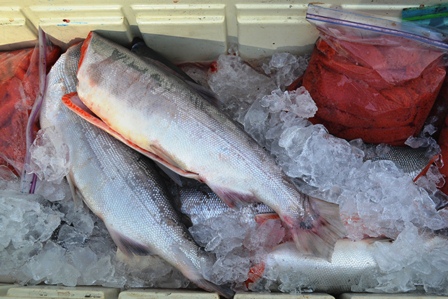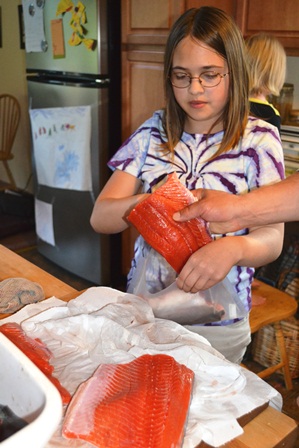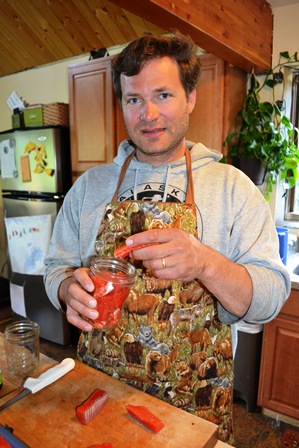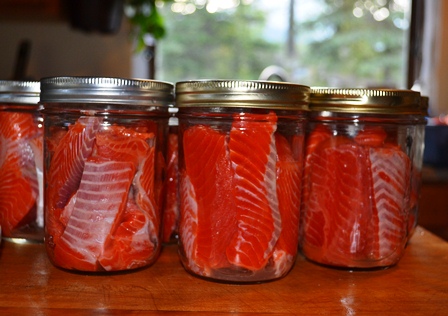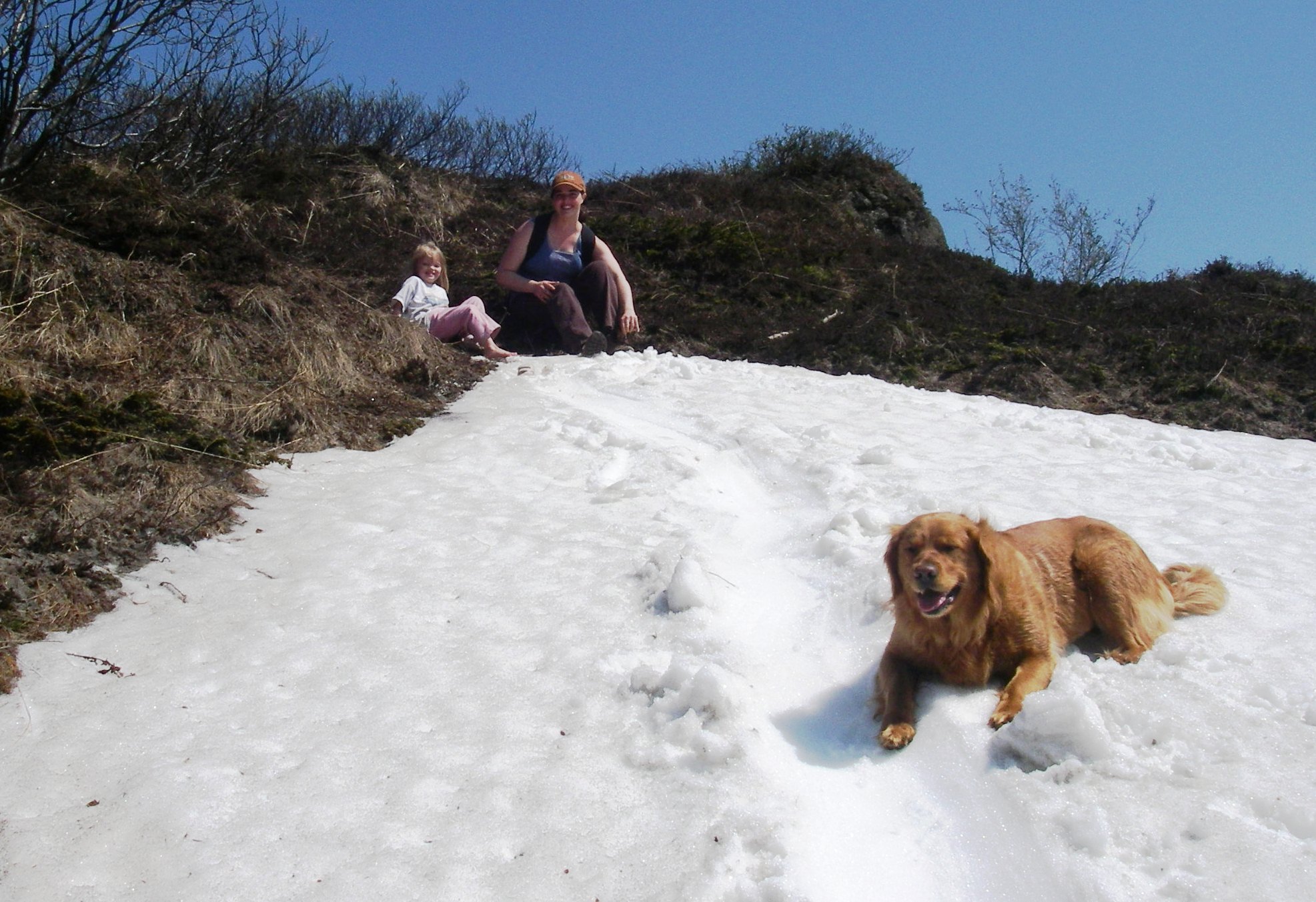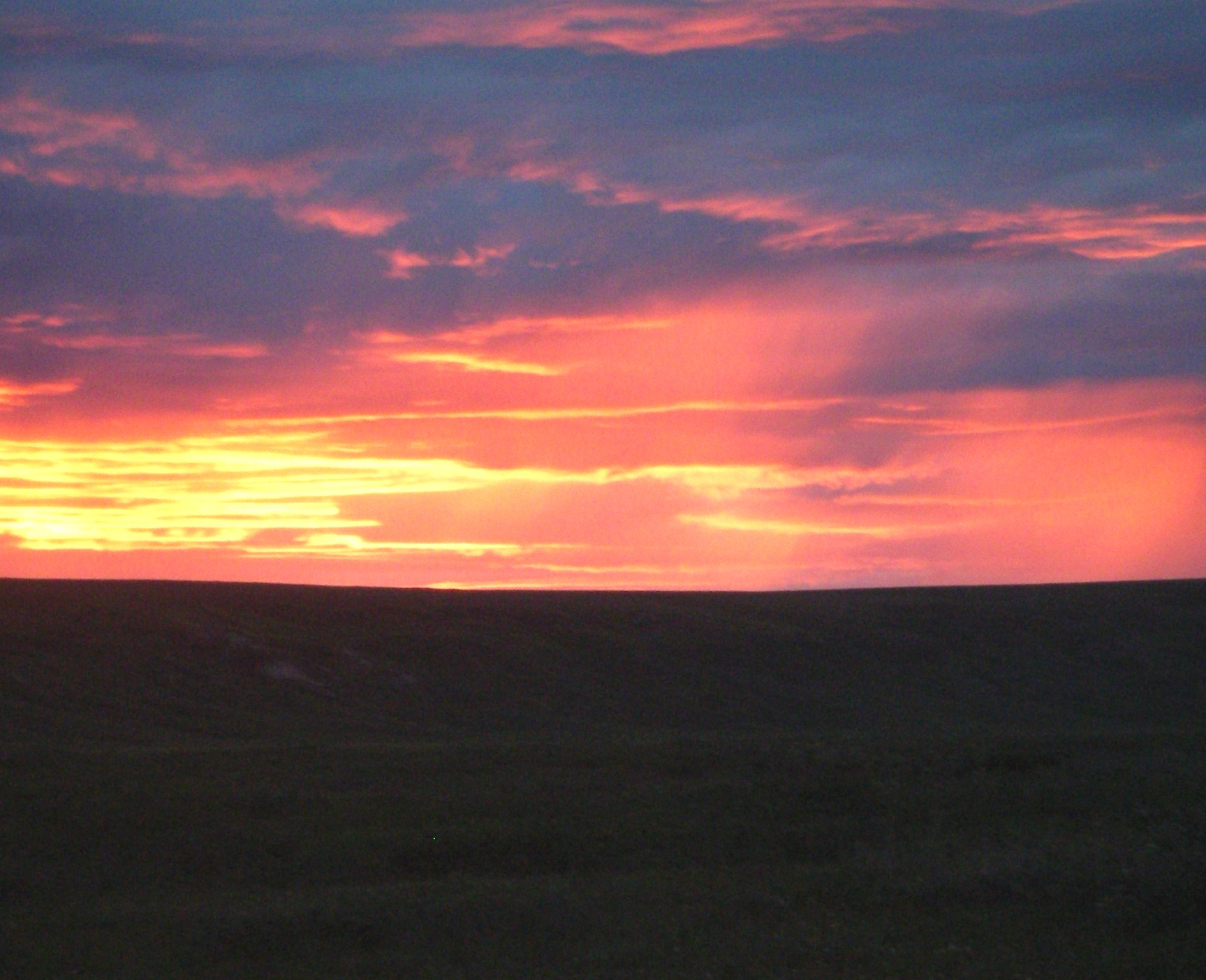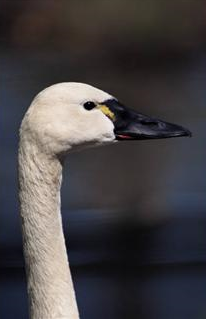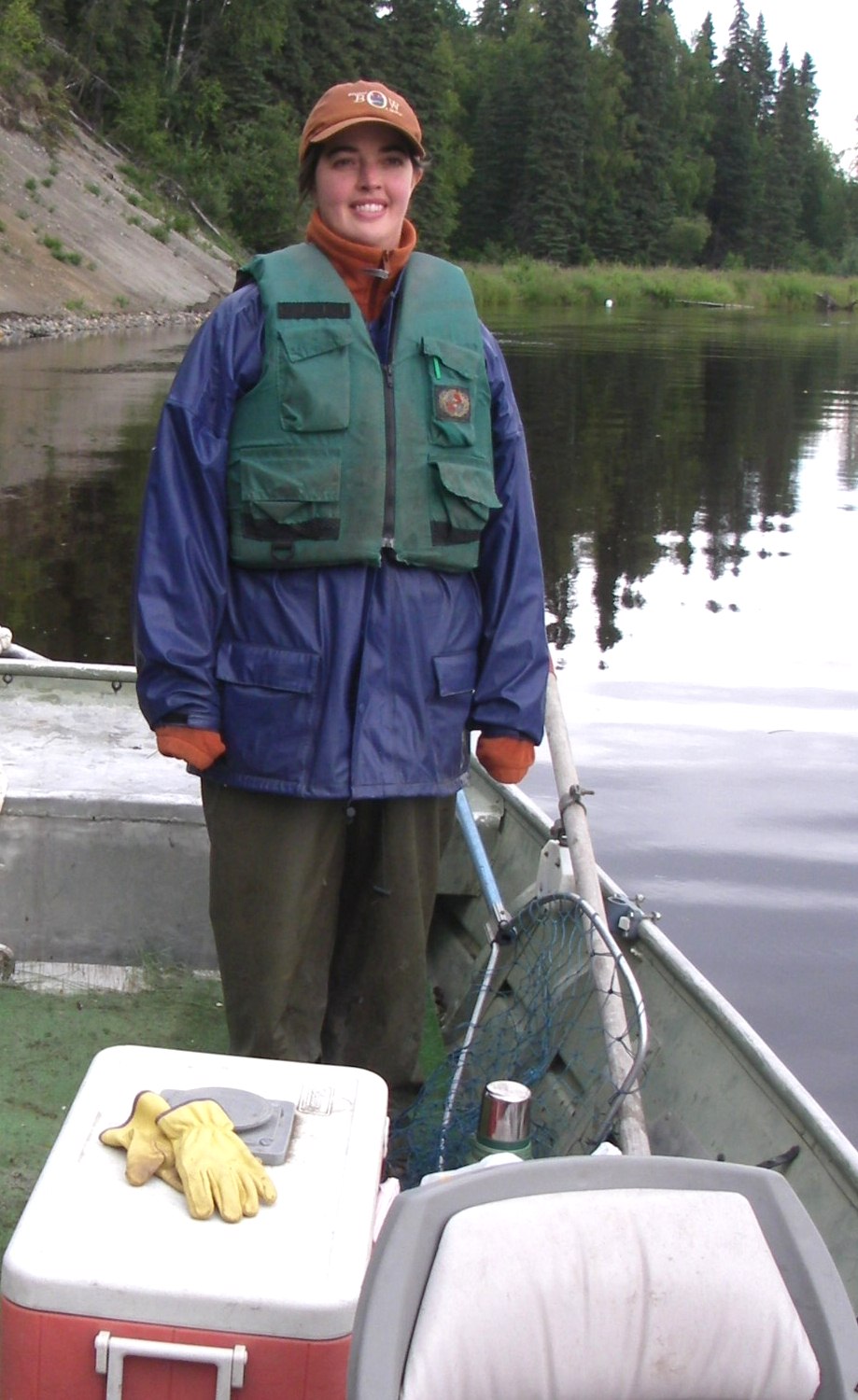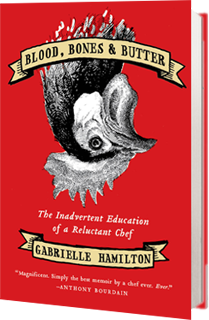Copper River reds
Dear hungry reader,
The salmon have returned to the rivers, so we Alaskans have, too. My husband and a group of friends spent two days on the Copper River, one of the most famous salmon streams. Regardless of where you live, it’s possible that you’ve seen Copper River sockeye on a menu or in a grocery store.
Dipnetting is one of the most popular methods for subsistence fishing. You lower a long-handled, wide net into the river and scoop the salmon out of the water. This type of fishing is allowed for Alaskan residents only, and in only a few rivers. It’s regulated to help people get their fish for the year while still protecting the salmon population.
When Sam went last week, each Alaskan family was allowed 40 fish. He brought home 35 sockeye, also know as red salmon, and one king salmon. This is a wonderful blessing, but it also means a lot of work. Everyone in the family pitched in over the course of two days, and now we have the salmon filleted and either preserved in jars or frozen in vacuum-sealed bags. Here are a few photos.
This catch alone will provide us with about 70 meals for the year. For dinners, we thaw the frozen fillets and grill it or bake it in the oven. The jarred salmon is cooked during the pressure cooking process. We store it in the root cellar, and use it to make something similar to tuna salad for sandwiches, salmon burgers, salmon-cream cheese spread, and pasta recipes, as well as just eating it out of the jar. It is some of the most healthy, flavorful meat in the world, and we’re thankful to have it! We’re also thankful to be done with the work. At least until we go king salmon fishing later this week.
Cheers!
Eowyn
Things That Are Not Actually Normal But Seem Sort of Normal After 30 Years in Alaska
Dear reliable reader,
One of my favorite bloggers, The Rejectionist, recently had a post called Things That Are Not Actually Normal But Seem Sort of Normal After 2.89 Years in New York City. It’s hilarious, and it inspired me to do my own homage to her genius.
So here is my list of things that are not actually normal but seem sort of normal after 30 years in Alaska —
spinning your vehicle 360 degrees on black ice in the middle of the highway, ending up back in your own lane facing the right direction, so continuing on to work as if nothing happened
breakup boots, not “Wellingtons” or “galoshes”
your 3-year-old daughter asking for moose during lunch at preschool, and then crying when told she will have to eat cow meat
sunrise at 11 a.m. followed by sunset at 3 p.m. or, if you prefer, sunset at 11 p.m., sunrise at 3 a.m.
Outside potatoes. True, all potatoes are grown outdoors. “Outside” potatoes are grown someplace like Idaho – Outside of Alaska
hiding your last-minute, grocery-store-bought Outside potatoes when your potato farmer friend comes for dinner
grinning sheepishly when your potato farmer friend finds Outside potatoes behind the box of beer in the pantry
trying to find a place for the 50 pounds of Yukon Golds your potato farmer friend unloads in your kitchen when he comes back the next day
flip-flops, with no socks, in the post office in the dead of winter. 15 degrees below zero, but who’s asking
40 rhubarb plants in your yard
your husband thinking 40 rhubarb plants might not be enough
$4.35 per gallon of gas in the oil capital of the United States
$18 for gallon of milk in Bush Alaska
knowing Bush Alaska is anywhere not on the road system, which is vast majority of state
537 mosquitoes inside one pup tent, and another million or so begging to get in
spending an hour in the middle of the night trying to kill the one mosquito that keeps bumping into your forehead
100% DEET
muktuk and akutaq as hors d’oeuvres at opening night of the community play
knowing akutuq is an Alaska Native traditional dish with seal fat, Crisco, and wild berries whipped together
thinking akutuq is kind of yummy
boiled caribou tongue served hot out of the pot in hunting camp
knowing that caribou tongue is awful and should never be eaten
elementary schools that allow outdoor recess down to 20 below zero
top secret berry picking spots
being sworn to secrecy when being led, blindfolded, to top secret berry picking spots
sparking a neighborhood feud when you accidently reveal top secret berry picking spot and 30 berry pickers show up with their buckets
hosting a party and having more snowmachines than automobiles parked in your driveway
partygoers knowing that it’s not just BYOB (bring your own beer) but also BYOS (bring your own sled) because the Iveys have the best sledding hill ever
coveting your neighbor’s smoked salmon recipe
trading your neighbor three packages of caribou pepperoni for one bag of smoked salmon and a jar of wild cranberry ketchup
seven months of darkness, snow, ice, and wind, and not wanting to live anywhere else in the world
Cheers!
Eowyn
The first adventure of the season
Dear determined reader,
I mentioned earlier this week that we were hoping to climb up to a nearby mountain to check out one of the last, dwindling patches of snow. The truth is, we’re wimps. When it gets above 70 degrees, which it did this week, we Alaskans overheat, and snow becomes very enticing. And as we discovered, brown bears must share this view.
Getting to the base of the mountain begins with an exciting drive down a deeply rutted four-wheel trail that is barely wide enough for one pick-up truck. Alder branches smacked at the side windows, and the truck lurched side to side. Part way down the bumpy trail, we stuck our truck in a mud hole. Even in four-wheel drive, the front tires just spun. While my husband and I lodged rocks and logs under the tires, our daughter bickered in the heat. We contemplated how long it would take to walk to our nearest neighbor’s house and ask for help.
But soon we heard the rumble of ATVs coming up the trail. I figured they would zip around us through the brush with maybe a quick nod in our direction. Instead, the family stopped and offered to hook their ATV to our truck and winch us out. (Note, the word “winch” rather than “wench.”)
Sam and I were skeptical that the ATV and its thin tether would do the job, but sure enough they pulled us right out of the mud. Whew.
We planned to park beside the mud hole and go on foot the rest of the way, though it meant we’d never make it all the way to snow. But the friendly people with the ATVs said, “Go for it. If you get stuck again, we’ll pull you out.” Hard to argue with that.
We drove to the foot trail without further incidence, waved goodbye to our new friends, and began the hike. We were sweating and hot, and our 4-year-old was whining before we even crested the first hill. But eventually we got into the rhythm of the hike and set our sights on that patch of snow.
As we walked, I told my daughters about how often we see bear tracks in the mud along this trail. Sometimes they’re smallish, black bear tracks. But sometimes they are huge brown bear tracks. The 4-year-old picked up her pace, hoping to catch sight of one of these curious animals. My older, wiser daughter began looking nervously over her shoulder.
After an hour or so, we climbed up out of the trees and into high alpine country. Lichen and blueberry bushes grew along the rocks, and the fragrance of blooming Labrador Tea filled the air.
We were all a bit sunburned by now, and feet were aching and hot. We all kept our eyes to that patch of snow. And then I saw something else. At first glance, I mistook it for a huge stump perched on the rocks. Then it turned its head side to side.
“Brown bear,” I called ahead to my husband, who carried the rifle.
We all stopped in the trail. I lifted up my youngest daughter, so she could see. The bear was about 300 yards ahead of us, sitting on his haunches, turning his head this way and that. Then he looked down at what I had come to think of as “our” patch of snow. After a minute or so, the bear stood and ambled slowly away from us, down into a valley and out of sight.
The old bruin was letting us have the first run at the snow patch. We took off our shoes and socks and squished our bare feet in the snow. The girls and our golden retriever took turns slipping down the snowy hill.
We didn’t see the brown bear again, but I’m certain as soon as we hiked off the mountain, he was out there, sliding his belly across that cool snow.
Cheers!
Eowyn
Build, hike, plant, climb — time to do it all
Dear sunny reader,
The mad frenzy of summer in Alaska has officially begun. 
Sleep? Who needs it? We’ve got gardens to tend, houses to build, fish to catch, and mountains to climb.
Our neighbors, the Baers, have already put a new roof on their home. And to clarify, because I know sane people in other places actually hire someone to do these sorts of things, when I say they put on a new roof, I mean THEY put on a new roof. As in the two of them ripped off the old shingles and plywood, put a massive blue tarp over it, and hoped it wouldn’t rain while they rebuilt the whole thing.
Another one of our good friends is a farmer, which means he is in full-on frenzy mode. The fields are now free of snow and the summer sun has begun to dry up the mud, so he is riding the tractor, planting night and day until the hundreds of acres are ready to sprout potato plants.
Across the way, our other neighbors just returned from their spring bear guiding trips. My dad is booming logs out of a pile in his yard, and my mom is studying for her MFA residency in poetry. She also teamed up with some other artists last weekend to lead an outdoor retreat in creativity, and she went for a hike with my brother near a local ski resort. She said the smell of the sun-warmed hemlock forest was delightful.
Sam, my husband, put on a dive suit and helped install a salmon weir on the Deshka River as part of his job as a fishery biologist, and in his off-hours he took out a window in our house and built our first staircase.
In the meantime, I tilled up our garden, hauled buckets of water from a creek, and planted cabbage, kale, broccoli, carrots, turnips and a few flowers, and set up my pea fence. Last night at 11 or so, I stood on our back porch. The sun had just set, so it was the soft blue of twilight. Looking out over the garden, I admired the neat rows of moist soil and lovely little seedlings. Then I saw the currants I had forgotten to transplant.
But today is a new day. We’re thinking about fertilizing the rhubarb, finishing the Sheetrock in the stairwell, and transplanting the currant bushes, as well as a lilac and mountain ash. We need to feed the chickens, water the garden. Oh, and we’re planning to climb up to the mountain behind our house to check out a little patch of snow that has lingered in the sun.
Our oldest daughter is worried we won’t have time to do it all, but I reminded her – we’ve got all day, and all night.
Happy summer!
Eowyn
Feathered locusts
I admit it – I’m somewhat of a romantic. I daydream about my home becoming a kind of Eden, where the golden retriever lounges on the porch, wildflowers bloom along the hill, chickens cluck about the yard, and strawberries ripen in the sun.
Reality isn’t as idyllic. They failed to mention it in THE OMNIVORE’S DILEMMA or ANIMAL, VEGETABLE, MIRACLE. Or if they did, I skimmed over it in with my rose-tinted glasses. But there is a dark side to paradise.
True, chickens are productive members of a farmish life. During the height of summer, we get as many as seven or eight fresh eggs a day, and because of the different breeds in our 12-chicken flock, the eggs come in blues, greens, tans, and speckled browns. They are beautiful, and flavorful.
And when we are feeling more pragmatic than sentimental, chickens make an excellent dinner. Keep in mind that “free range” also means “tougher than hell.” But that’s why we have a pressure cooker.
In addition to being productive and delicious, however, chickens possess another prominent characteristic – they will eat anything. Absolutely anything. They are like feathered locusts.
In Eden, that means they eat the leftover table scraps and the unwanted weeds and bugs in the yard. Here in the real world, though, it means they eat everything else, too.
I’m not always quick on the uptake. Last summer I planted two raised beds with strawberry plants. I watched the flowers bloom and tiny green strawberries appear. And, just as they began to ripen, disappear.
In the meantime, there were other mysterious goings-ons. Like the rhubarb plants whose leaves were riddled with bite-sized holes.
And then it struck me. Chickens! As they free-ranged their way across our yard, they were consuming everything. Including just-ripened strawberries and rhubarb plants. Yes I know, rhubarb leaves are supposed to be toxic. Our chickens appear to be perfectly healthy eating machines.
I announced loudly off the back porch that if they attacked my plants again, we would be having chicken for dinner, with a strawberry glaze. The flock seemed unfazed. My dad later suggested it might be easier to just put a fence around the strawberry beds.
So this past week, when I noticed the strawberry and rhubarb plants emerging from the moist soil, I got out the heavy artillery. I will not relinquish Eden! Our chickens WILL free range, and our strawberries WILL be fruitful. I spent most of an afternoon erecting around the strawberries what I learned at the local hardware store is called “welded wire fencing.” And tomorrow I will do the same to some of our many rhubarb plants. Be forewarned, chickens – the free-range smorgasbord has been closed!
Cheers!
Eowyn
Homo sapiens alaskana
During my first trip to visit my publisher in New York City, I was talking with one of the editors when, in passing, he said something about Alaska being somewhat exotic.
“Oh, I don’t know. Not really,” I said. “I mean we have our Wal-Marts and Targets and McDonalds.” We went on to talk about skiing and traveling. Then I mentioned we had just returned from our annual caribou hunting trip. We had traveled to what is called the “North Slope” near the Arctic Ocean and brought back several caribou.
“You hunted caribou?” he asked.
“Sure. It’s our meat for the year,” I said.
“Yeah,” he said. “That’s kind of exotic.”
And I knew he was right. In most parts of America, people don’t go caribou hunting for their family vacation.
But here among other Alaskans, we are not exotic. We are actually kind of run-of-the-mill. We have neighbors who eat exclusively from the garden and the wild. They store their cabbages, beets, potatoes and other vegetables in a large root cellar. Salmon, moose, wild berries. That’s pretty much it. They also built their small log cabin with lumber they milled themselves off their land.
Up and down the road, you can also find big-screen TVs, hot tubs, and hybrid cars. And most of us straddle a kind of middle ground. Many of us raise gardens and farm animals, harvest wild berries, and fill our freezer with salmon. Alaskans who don’t hunt will rarely turn down a moose roast if one is offered, and like in Lake Wobegon, people are apt to find zucchinis at their doorstep when harvest comes.
We live too far out to have it delivered, but some Fridays as a treat we bring pizza home from town. We top it with caribou pepperoni and watch a movie from Netflix. Other nights, dinner might be moose steak, potatoes from our friend’s field, a salad from our garden, and homegrown rhubarb in a pie for dessert.
True, my husband runs a 50-mile trapline each winter in glacier country. And it’s also true that I once shot a black bear off our front porch and turned it into hot dogs. Our place is like many modern Alaskan “homesteads” – a nearly finished house, a stack of firewood to be split, a garden that gets munched by moose occasionally, and an incredible view of the mountains. But my kids also love macaroni and cheese and SpongeBob Squarepants DVDs. And I have a weakness for good espresso and the gourmet chocolates made at a local shop.
It’s a similar line I straddle when writing this blog. I hope to share some of what makes our home unique. But the journalist in me also wants to paint an accurate picture.
And I promise to tell you about the black bear on the porch.
Cheers,
Eowyn
Goodbye night
Dear tireless reader,
This week in Barrow, Alaska, the sun will rise one last time and not go down again until August. Twenty-four hours of daylight, all summer long.
We live hundreds of miles south of Barrow, but even here in Southcentral Alaska, the days are growing long. Last night the sun didn’t set until 10:30 p.m., and it was back up at 5 this morning. Once we hit summer solstice in June, we will have just over four hours of “night”, but even then the dark isn’t really dark. It’s a kind of long twilight.
This drives some people nuts. In the summers, they have to darken their rooms with blanket-style curtains and still the chirping of songbirds at midnight keeps them awake. Then, when the black nights of winter return, some find it gloomy and depressing.
But I love the extremes of this place. It might help that I grew up here. I do sleep less in the summer. This time of year, we find ourselves working on projects until 9 at night without realizing the hour. Once summer is in full swing, we’ll be weeding the garden at 10 p.m. and letting the kids run around in the yard until 11. The next morning, we won’t be as tired as we should. Partly because it will be light well before we crack open our eyes.
Summer in Alaska is a time to go, go, go. Some days we will rise at 4 a.m. to go king salmon fishing, sipping coffee in the pickup truck as we tow the boat to the landing. Other nights we’ll drink homebrew and play bocce ball on a neighbor’s lawn until midnight. I push away the fatigue, knowing that once winter comes, I’ll have plenty of time to sleep.
One summer when my husband and I were back home from college, he stayed up all night helping a friend bring in his hay crop. I remember standing in the field at 3 a.m., robins calling from the trees, the sky that tender, pale blue. I knew I was home.
Cheers!
Eowyn
Friday Hodgepodge
Dear steadfast reader,
In Alaska this week, breakup arrived in full force. For people who live Outside (as in “not in Alaska”), breakup is our equivalent of spring. Don’t picture crocuses, cherry blossoms, and a gentle, warm breeze. Instead think mud, slush, rain mixed with snow, the first hatch of mosquitoes, and huge blocks of ice floating down the rivers.
While it might sound like a great way to kick off the weekend, hitching a ride on one of those giant ice cubes could apparently land you in jail.
And for the gambling types, you missed your chance to bet on when the ice would go out on the Tanana River. The winners took home thousands of dollars … from the losers.
Through a more pastoral lens, breakup also brings millions of migratory birds back home to Alaska, because of course this is home. Sandhill cranes, snow geese, mallard ducks, and many other species are gathering in local farmers’ fields. And soon, the breeding pair of swans will return to our nearby lake.
In bookish news, I confess that over the past couple of years I have become somewhat of a blog hound. Here are some of my favorite finds:
- Even if you don’t relish Russian novels, or 12-hour theater performances, I still think you’ll get some laughs out of this several-part review by Elif Batuman for The Paris Review blog. I wouldn’t normally put “Dostoevsky” and “side-splittingly funny” in the same sentence, but here it is.
- This is where you’ll find out the truth about what I’m doing when I’m “working on my novel.” Tahereh Mafi’s blog is terrific, but this one struck particularly close to home.
- And in honor of Mother’s Day, an oldie but goodie from one of my favorite bloggers, The Rejectionist. WARNING: contains words of a more colorful nature.
Happy weekend!
Eowyn
What not to wear
Dear fashionable reader,
I was recently invited to a dinner in Manhattan with some other authors. It’s not very sophisticated or progressive of me, but one of my first thoughts – after “Yippeee!” and “Really? I get to go?” – was “Oh, no. What am I going to wear?”
I have come to discover that the rest of the world does not dress in rubber boots, holey corduroys, and fleece jackets, at least not all the time. Here in Alaska, at the opera you’re as likely to see blue jeans and Carhartts as gowns and tuxedos. Alaskans are known to be a lot of things, but fashionable rarely tops the list.
My obsession with choosing something to wear began to keep me up at night. A fellow Alaskan advised me to look at it as if I were traveling to an exotic country. I should research the culture and customs. So I asked some Manhattan regulars – my editor and publicist. I was advised that the dinner wouldn’t be an excessively dressy event. So my first thought was out …
I’ve also been told that while people may be charmed by a little bit of “rustic Alaska,” I should make sure to not dress like a hick. I’m assuming that means no fishing/hunting gear …
… which is too bad, because lifejackets and rain gear are so slimming on me, and leather work gloves are always an elegant accessory.
But I was completely at wit’s end when my publicist begged me to please leave the moose hat at home. Darn!
(This photo is actually from a blog called Heinous Hats. Who knew?)
But, seriously, I want to have some pizazz, to show people that Alaskans are creative, fun-loving people. So, taking all of this into consideration, I think I’ve finally settled on a look …
(Just kidding, Marlena!)
Cheers,
Eowyn
BLOOD, BONES, BUTTER & BEAR
Dear ravenous reader,
I just read BLOOD, BONES & BUTTER by Gabrielle Hamilton, a chef who has a restaurant in New York City. I don’t read a lot of memoirs, but it seems that when I do, they are often of the chef variety. I loved Julia Child’s MY LIFE IN FRANCE, but BLOOD, BONES & BUTTER offers a very different, gritty and unsentimental view.
One of my favorite scenes in Hamilton’s book is when she tells of her father’s annual lamb roast. She describes the night as being filled with fireflies and laughter, and the lamb meat being roasted with olive oil, crushed rosemary and garlic. It called to my mind a somewhat similar gathering from my own childhood. Except we weren’t in Pennsylvania, but rather Alaska, and our meat du jour was not lamb.
One summer when I was about 6 or 7 years old, a black bear prowled our neighborhood. We lived along a gravel road in an area many people would call rural, but by Alaskan standards was nearly the suburbs. The bear was spotted by several people up and down the road, so my dad went on foot in search of it. In the middle of the day, I stepped out on the porch to see a lanky, dark animal dart past. I thought it was a dog, but my mom said it was the bear. Later that same day, my dad shot the bear out of a tree.
That night, everyone gathered around a campfire and ate roasted bear meat. It was an Alaskan summer, so never truly dark. The sky was the faded blue of twilight, but the forest around the houses was shadowy. I remember swinging in a hammock, just outside of the campfire light, and eating a hunk of roasted bear meat sandwiched in a dinner roll. The meat was warm, scented with wood smoke, and slathered in barbeque sauce. It had a coarser texture that beef, but was tender in my mouth. I remember thinking it was the best thing I had ever tasted in my life.
The adults stood at the fire, drinking and talking. I finished my bear meat, and then lay back in the hammock to look up through the spruce boughs. I was at the cool night’s edge of fire light and darkness, safety and danger. It is an exhilarating memory, and one that is intertwined with the taste and smell of that bear meat.
They say that scent is one of the strongest triggers of memory. But I think taste, too, can be incredibly evocative.
I’d love to hear about your food memories.
Eowyn

